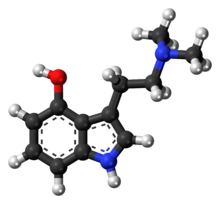Psilocin
 |
|
 |
|
| Clinical data | |
|---|---|
| Routes of administration |
Oral, IV |
| ATC code | none |
| Legal status | |
| Legal status |
|
| Pharmacokinetic data | |
| Metabolism | Hepatic |
| Biological half-life | 1-3 hours |
| Excretion | Urine |
| Identifiers | |
|
|
| Synonyms | 4-hydroxy-N,N-dimethyltryptamine |
| CAS Number |
520-53-6 |
| PubChem (CID) | 4980 |
| ChemSpider |
4807 |
| KEGG |
C08312 |
| ChEBI |
CHEBI:8613 |
| ChEMBL |
CHEMBL65547 |
| ECHA InfoCard | 100.007.543 |
| Chemical and physical data | |
| Formula | C12H16N2O |
| Molar mass | 204.27 g/mol |
| 3D model (Jmol) | Interactive image |
| Melting point | 173 to 176 °C (343 to 349 °F) |
|
|
|
|
|
|
|
Psilocin (also known as 4-HO-DMT, psilocine, psilocyn, or psilotsin) is a substituted tryptamine alkaloid and a serotonergic psychedelic substance. It is present in most psychedelic mushrooms together with its phosphorylated counterpart psilocybin. Psilocin is a Schedule I drug under the Convention on Psychotropic Substances. The mind-altering effects of psilocin are highly variable and subjective and resemble those of LSD and DMT.
Psilocin and its phosphorylated cousin, psilocybin, were first isolated and named in 1958 by Swiss chemist Albert Hofmann. Hofmann obtained the chemicals from laboratory-grown specimens of the entheogenic mushroom Psilocybe mexicana. Hofmann also succeeded in finding the synthetic routes to these chemicals.
Psilocin can be obtained by dephosphorylation of natural psilocybin under strongly acidic or under alkaline conditions (hydrolysis). Another synthetic route uses the Speeter-Anthony tryptamine synthesis starting from 4-hydroxyindole.
Psilocin is relatively unstable in solution due to its phenolic hydroxy (-OH) group. In the presence of oxygen it readily forms bluish and dark black degradation products. Similar products are also formed under acidic conditions in the presence of oxygen and Fe3+ ions (Keller's reagent).
...
Wikipedia
